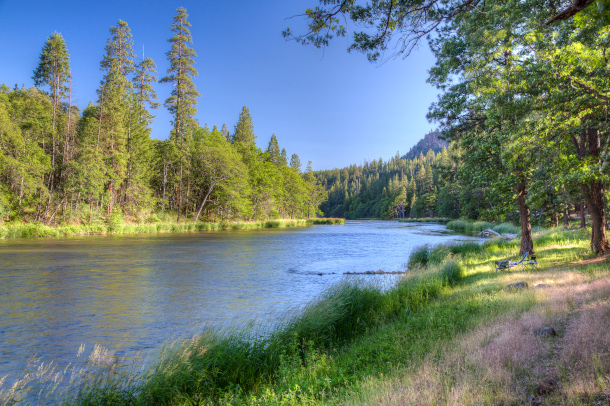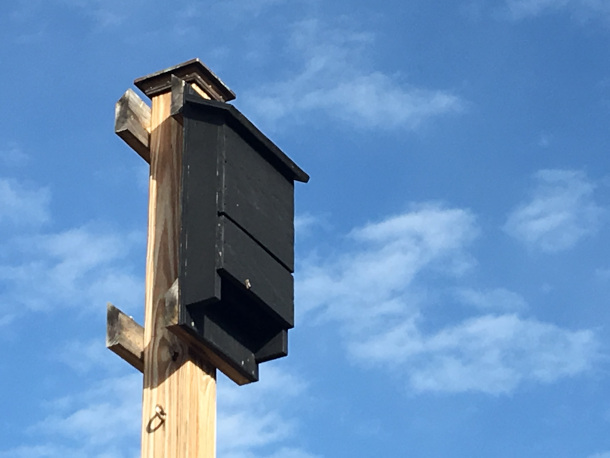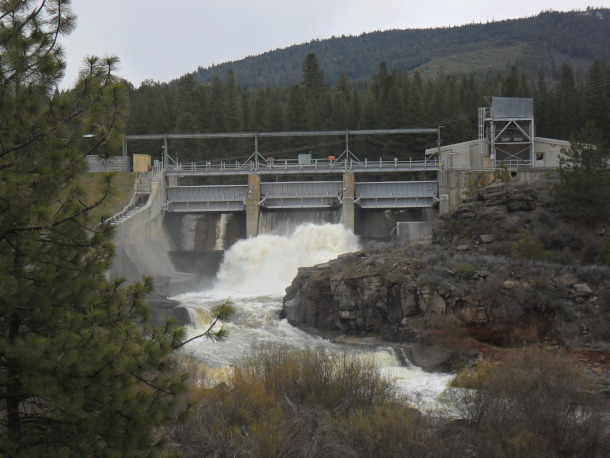Helping Bats Survive Klamath Dam Removal
Air Date: Week of November 10, 2023

The Klamath River stretches 257 miles across Oregon and California and is home to many types of wildlife, and acts as a water resource to nearby communities. The dam removal process is intended to encourage ecological restoration. (Photo: Bureau of Land Management Oregon and Washington, Wikimedia Commons, Public Domain)
The removal of four Klamath River dams along the California-Oregon border is expected to give salmon vital access to spawning grounds and is also giving a boost to research on how some other native species including bats can adapt to the change. Reporter Kristian Foden-Vencil of Oregon Public Broadcasting has this story about what bat researchers hope to learn.
Transcript
O’NEILL: It’s Living on Earth, I’m Aynsley O’Neill
DOERING: And I’m Jenni Doering. The first of four Klamath River dams along the California-Oregon border has now been removed, with the rest to follow next year. Letting the Klamath flow free once again is expected to give salmon vital access to their spawning grounds upriver. It’s also giving a boost to research on some other native species, including bats. Oregon Public Broadcasting reporter Kristian Foden-Vencil has this story.
FODEN-VENCIL: At the bottom of the J.C. Boyle Dam, just outside Klamath Falls, stands an old shed. It's unremarkable in just about every way, except that it's home to a colony of bats.
ADKINS: There's just a data gap on a lot of these species and really on bats in the Pacific Northwest as the whole.
FODEN-VENCIL: Kaly Adkins is a conservation biologist with the Oregon Department of Fish and Wildlife. She manages non-game species like pygmy rabbits, Sierra Nevada red foxes, and of course, bats. Stooping to fit in the old 1950s shed, she says it's unique in a couple of bat-friendly ways. First, it's tiny. Bats love to hide away. Second, it has a corrugated metal roof so it gets nice and warm in the summer, perfect for rearing bat pups. But most importantly of all, the shed stands right above the dam spillway. So there's a constant flow of water underneath it.
ADKINS: We can assume that it gets pretty warm up at the top, but then there's almost like an air conditioning factor of the cool water running underneath it.

This is an example of a Bat Box, similar to that described by Kaly Adkins. (Photo: MarkBuckawicki, Wikimedia Commons, Public Domain)
FODEN-VENCIL: There are holes in the floor, so cool, moist air can flow in and the bats can swoop out into the bug-laden evening. There are no bats here today. Adkins thinks the shed's being used as a nursery, and all the pups have grown and flown. The shed's purpose is to house machines that lift and lower water gates so that if the dam turbines need to be fixed, water can be diverted around the dam and out the spillway. Next year, it's scheduled to be knocked down along with the rest of the dam. Bats are a protected species. So when they need to be moved from a dam or someone's house, the state advises bat boxes be set up nearby to provide alternative habitat. As a state biologist, Adkins says she's constantly being asked, what's the best kind of bat box, where should it be placed? And how big should it be?
ADKINS: I went to the literature to try to understand and give a scientific explanation behind what I was recommending. And there just wasn't a whole lot of information available.
FODEN-VENCIL: Now she's using the dam removal as an experiment to figure out what kind of replacement bat boxes bats actually prefer, and where's the best place to locate them. The first step involves tracking the bats, so she put up nets outside the shed to catch and tag them, she injected a microchip under their skin, just like vets do with dogs.
ADKINS: We captured and tagged over 100 bats.

The J.C. Boyle dam is scheduled to be removed along with three other dams along the Klamath river. (Photo: Bob J Galindo, Wikimedia Commons, CC BY-SA 3.0)
FODEN-VENCIL: Then, she put up a series of different bat boxes in different locations. The first is just 100 yards from the old shed. The second is about a mile and a half away next to a lake. At each site she installed several large bat boxes, which she calls bat condos. They're about the size of a carry on suitcase and can hold the whole colony of 100 bats. She's also installed several smaller cylindrical bat boxes, which mimic the shape of a dead tree, their natural habitat. The boxes are on poles 10 feet off the ground to protect them from predators like skunks and raccoons. And they're in spots that Adkins thinks offer the right temperature and humidity.
ADKINS: So we're looking for good morning sunlight, but then not a whole lot of midday or afternoon sunlight because we want it to warm up quickly in the morning, but not bake.
FODEN-VENCIL: While some people are scared of bats, they're actually beneficial in a number of ways. They help keep insect populations under control, like mosquitoes and pine bark beetles, and in some areas that even pollinate plants, but not in the Pacific Northwest. There's a note of urgency to the bat box study too because of a fungal disease known as white nose syndrome. It can cause mass bat die offs. Bronwyn Hogan, who coordinates the US Fish and Wildlife response to the disease, says it's gradually spreading west from the Eastern US, and has been found in Washington and Idaho.
HOGAN: So far they fungus has not been detected in Oregon. In California, the fungus has been detected at very low levels.
FODEN-VENCIL: The fungus grows on the noses of bats and wakes them out of hibernation. They then spend scarce energy searching for insects that aren't around. Bat numbers are also declining because of habitat loss, the spread of wind farms, and a lack of insects. Back at J.C. Boyle Dam, the shed isn't likely to be demolished until next fall. So now Adkins waits in the knowledge that the colony could ignore her bat boxes altogether and disappear into the surrounding forest. But then that's the nature of scientific experiment. For Living on Earth, I'm Kristian Foden-Vencil.
DOERING: That story comes to us from OPB, Oregon Public Broadcasting.
Links
Find this story and more from Oregon Public Broadcasting
More information on the JC Boyle dam
More information on bats in Oregon.
Oregon Fish and Wildlife | “Bat House Plan Modifications for the Pacific Northwest”
Living on Earth wants to hear from you!
Living on Earth
62 Calef Highway, Suite 212
Lee, NH 03861
Telephone: 617-287-4121
E-mail: comments@loe.org
Newsletter [Click here]
Donate to Living on Earth!
Living on Earth is an independent media program and relies entirely on contributions from listeners and institutions supporting public service. Please donate now to preserve an independent environmental voice.
NewsletterLiving on Earth offers a weekly delivery of the show's rundown to your mailbox. Sign up for our newsletter today!
 Sailors For The Sea: Be the change you want to sea.
Sailors For The Sea: Be the change you want to sea.
 The Grantham Foundation for the Protection of the Environment: Committed to protecting and improving the health of the global environment.
The Grantham Foundation for the Protection of the Environment: Committed to protecting and improving the health of the global environment.
 Contribute to Living on Earth and receive, as our gift to you, an archival print of one of Mark Seth Lender's extraordinary wildlife photographs. Follow the link to see Mark's current collection of photographs.
Contribute to Living on Earth and receive, as our gift to you, an archival print of one of Mark Seth Lender's extraordinary wildlife photographs. Follow the link to see Mark's current collection of photographs.
 Buy a signed copy of Mark Seth Lender's book Smeagull the Seagull & support Living on Earth
Buy a signed copy of Mark Seth Lender's book Smeagull the Seagull & support Living on Earth

